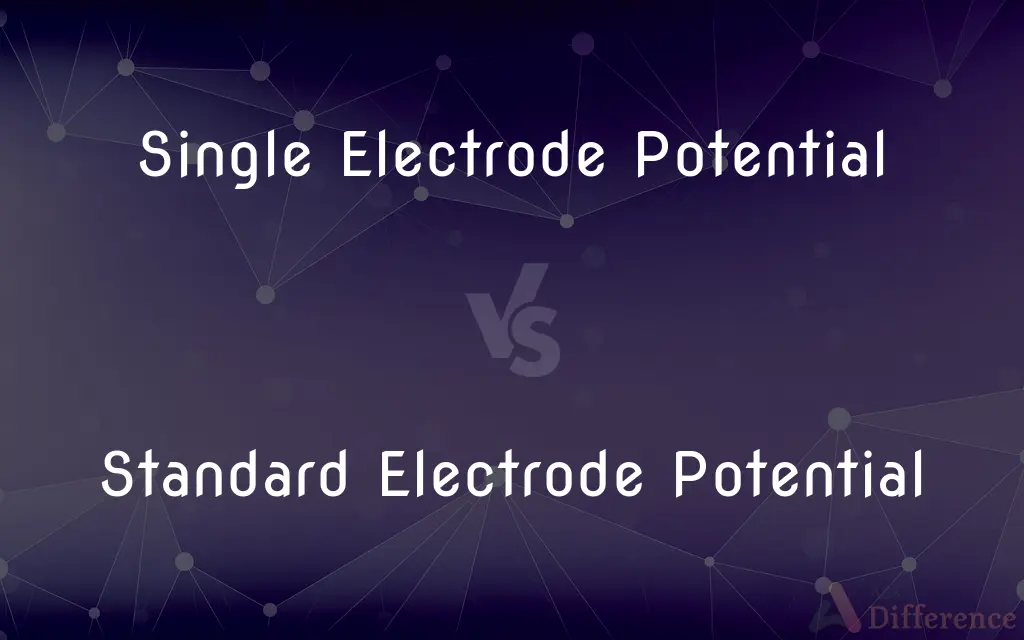Single Electrode Potential vs. Standard Electrode Potential — What's the Difference?
By Tayyaba Rehman — Published on November 2, 2023
Single Electrode Potential refers to the voltage of an electrode in a given solution, while Standard Electrode Potential denotes its voltage under standard conditions.

Difference Between Single Electrode Potential and Standard Electrode Potential
Table of Contents
ADVERTISEMENT
Key Differences
The Single Electrode Potential is essentially the voltage or potential difference of a half-cell in an electrochemical cell when connected to a reference electrode. It's measured under any set of conditions and depends on the concentration of ions in the solution and the temperature. Conversely, the Standard Electrode Potential is a specific type of Single Electrode Potential, but it's measured under standard conditions. This includes a temperature of 25°C, a pressure of 1 atm, and a concentration of 1M for all reactants and products. It provides a benchmark to compare the tendency of different electrodes to lose or gain electrons. Every element's Standard Electrode Potential is gauged against the hydrogen electrode, which is assigned a potential of zero volts.
Comparatively, the Single Electrode Potential provides real-time data about an electrode under a specific set of conditions. The Standard Electrode Potential gives a systematic way of ranking different redox couples and predicting the direction of redox reactions.
Comparison Chart
Definition
Voltage of a half-cell under any condition.
Voltage of a half-cell under standard conditions.
Conditions
Variable depending on the environment.
25°C, 1 atm pressure, 1M concentration.
Reference Comparison
Can be compared to any reference electrode.
Compared to the hydrogen electrode set at 0 volts.
ADVERTISEMENT
Utility
Provides potential under specific scenarios.
Offers a standard reference for various electrodes.
Predictability
May not predict reaction direction outside given conditions.
Used to predict direction of redox reactions universally.
Compare with Definitions
Single Electrode Potential
Represents the voltage of a half-cell against a reference.
The Single Electrode Potential of the cell varied due to the concentration change.
Standard Electrode Potential
Determined at 25°C, 1 atm, and 1M concentration.
The Standard Electrode Potential provides consistency for comparing different electrodes.
Single Electrode Potential
Dependent on specific conditions like temperature and ion concentration.
Changes in the solution altered the Single Electrode Potential significantly.
Standard Electrode Potential
Represents the intrinsic property of a redox couple.
The high Standard Electrode Potential showed the substance's strong oxidizing power.
Single Electrode Potential
Useful for understanding real-time electrode behaviors.
To monitor the battery's health, they checked the Single Electrode Potential frequently.
Standard Electrode Potential
Utilized as a reference point for comparing electrode tendencies.
Based on its Standard Electrode Potential, we predicted the electrode's behavior.
Single Electrode Potential
Provides insights on the half-cell's tendency to release or accept electrons under certain conditions.
The high Single Electrode Potential indicated the electrode's strong oxidizing nature.
Standard Electrode Potential
Voltage of a half-cell measured under standardized conditions.
The Standard Electrode Potential is a key value in electrochemical tables.
Single Electrode Potential
Can fluctuate based on external factors.
Variations in temperature caused a shift in the Single Electrode Potential.
Standard Electrode Potential
Integral for foreseeing the direction of redox reactions.
Using the Standard Electrode Potential values, they identified the reaction's spontaneity.
Common Curiosities
Why is Standard Electrode Potential important in electrochemistry?
It provides a consistent reference for comparing electrode tendencies.
How is Standard Electrode Potential different from Single Electrode Potential?
It's the Single Electrode Potential measured under standard conditions.
Can the Single Electrode Potential vary for the same electrode?
Yes, it can vary based on conditions like temperature and ion concentration.
Are Standard Electrode Potential values constant for an element?
Yes, they're consistent under standard conditions.
What does Single Electrode Potential represent?
It represents the voltage of a half-cell against a reference under specific conditions.
Which electrode is the Standard Electrode Potential typically referenced to?
The hydrogen electrode set at 0 volts.
How can external factors affect Single Electrode Potential?
Factors like temperature, pressure, and ion concentration can influence it.
Why is the hydrogen electrode set at 0 volts in Standard Electrode Potential?
It serves as a universal reference point in electrochemistry.
Can Single Electrode Potential predict the spontaneity of reactions?
It can, but only under the specific conditions it's measured.
Does Single Electrode Potential have a universal standard?
No, it can vary based on the specific conditions present.
Is Single Electrode Potential essential for practical applications?
Yes, it provides real-time data on an electrode's behavior under specific conditions.
How do Standard Electrode Potential values help in constructing electrochemical cells?
They help determine which electrode will act as the cathode or anode in a cell.
How do you measure Standard Electrode Potential?
By connecting an electrode to a standard hydrogen electrode under set conditions.
Can two electrodes have the same Standard Electrode Potential?
Theoretically, it's possible if they have the same tendency to lose or gain electrons under standard conditions.
Can Single Electrode Potential be converted to Standard Electrode Potential?
Not directly; adjustments considering the conditions are needed to compare them.
Share Your Discovery

Previous Comparison
Atmospheric Distillation vs. Vacuum Distillation
Next Comparison
Rales vs. RhonchiAuthor Spotlight
Written by
Tayyaba RehmanTayyaba Rehman is a distinguished writer, currently serving as a primary contributor to askdifference.com. As a researcher in semantics and etymology, Tayyaba's passion for the complexity of languages and their distinctions has found a perfect home on the platform. Tayyaba delves into the intricacies of language, distinguishing between commonly confused words and phrases, thereby providing clarity for readers worldwide.













































